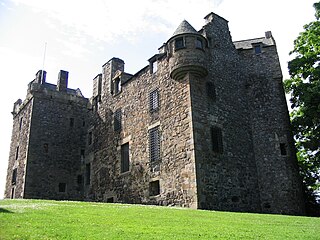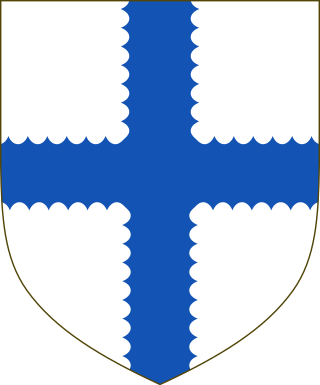Related Research Articles

Wemyss Castle is situated in Wemyss on the sea cliffs between the villages of East Wemyss and West Wemyss in Fife, Scotland. Wemyss Castle is considered to be a multi-period building, and today's castle includes many elements from former periods such as the 15th century tower and the 19th century stables and gatepiers.

Earl of Wemyss is a title in the Peerage of Scotland created in 1633. The Scottish Wemyss family had possessed the lands of Wemyss in Fife since the 12th century. Since 1823 the earldom has been held with the Earldom of March, created in 1697. The holder of the title is sometimes known as the Earl of Wemyss and March, but the titles are distinct.

Elcho Castle is located close to the south bank of the River Tay approximately four miles south-east of Perth, Scotland, in the region of Perth and Kinross. It was maintained by Clan Wemyss from its construction around 1560 until it was put into the care of the Secretary of State for Scotland in the early 20th century, though was not occupied for the entire time. In around 1830 it was re-roofed and a nearby cottage constructed. The castle has been a scheduled monument since 1920 on the grounds of being "a particularly fine example of a Medieval tower-house", and the cottage became a listed building in 1971 in recognition of its national importance. The castle is unusual in that it has both en suite guest accommodation like a mansion, but also a large number of gun loops.

Clan Wemyss is a Lowland Scottish clan.
John Wemyss, 1st Earl of Wemyss (1586–1649) was a Scottish politician.
David Wemyss, 2nd Earl of Wemyss was an army officer.
Margaret Wemyss, 3rd Countess of Wemyss and Countess of Cromarty was a Scottish peer.
Michael Balfour, 1st Lord Balfour of Burleigh PC was a Scottish peer.

Agnes Leslie, Countess of Morton was a Scottish noblewoman, being the daughter of George Leslie, 4th Earl of Rothes. She was the wife of William Douglas, 6th Earl of Morton, who as Laird of Lochleven Castle was the custodian of Mary, Queen of Scots during her captivity from June 1567 until her escape on 2 May 1568. Agnes was Queen Mary's chief female companion throughout her imprisonment; thus it was while Lady Agnes was recovering from childbirth that the queen successfully escaped from Lochleven.
Archibald Douglas, Earl of Angus, 1st Earl of Ormond was the eldest son of William Douglas, 1st Marquis of Douglas, from whom he obtained the courtesy title of Earl of Angus. Douglas was a member of privy council of Scotland, 1636; vacillated in his opinions on the new service-book, originally (1636) approving its use. Appointed extra ordinary lord of session in 1631. He signed the covenant, was unwilling to take up arms in its defence, but was a commissioner for the covenanters in England in 1643. In 1646 made colonel of Régiment de Douglas in France when his brother Lord James Douglas, was killed in action. Member of committee of estates in 1650. Created Earl of Ormond in 1651; fined £1,000 by Cromwell's Act of Grace, 1654.
John Balfour, 3rd Lord Balfour of Burleigh was a Scottish nobleman. He was educated in France; and has been traditionally and erroneously styled Covenanter John Balfour, the Covenanter being John Balfour of Kinloch.
Robert Balfour, 2nd Lord Balfour of Burleigh was a Scottish military commander.
Elcho Priory was a medieval Cistercian priory in Perthshire, Scotland, dedicated to the Virgin Mary.

John Wemyss younger of Logie, (1569-1596), was a Scottish courtier, spy, and subject of the ballad "The Laird o Logie", beheaded for plotting to blow up a fortification at Veere in the Netherlands.
Simon Fraser, 6th Lord Lovat (1570–1633) was a Scottish courtier and landowner.

Margaret or Margrethe Vinstarr, was a Danish courtier in Scotland to Anne of Denmark commemorated by the ballad "The Laird o Logie" for rescuing her imprisoned lover.
James Stewart, 1st Lord Doune (1529-1590) was a Scottish landowner.
Sir John Wemyss was a Scottish landowner.

Henry Sinclair was a Scottish noble and the 4th Lord Sinclair. In The Scots Peerage by James Balfour Paul he is designated as the 3rd Lord Sinclair, but historian Roland Saint-Clair designates him the 4th Lord Sinclair and references this to an Act of the Scottish Parliament in which he was made Lord Sinclair based on his descent from his great-grandfather, Henry II Sinclair, Earl of Orkney, the first Lord Sinclair. Bernard Burke, in his a Genealogical and Heraldic Dictionary of the Peerage and Baronetage of the British Empire, agrees with Roland Saint-Clair and says that Henry Sinclair was "in reality" the fourth holder of the title of Lord Sinclair.
Sir John Seton was a Scottish aristocrat and soldier who wrote letters to his cousin Alexander Montgomerie, 6th Earl of Eglinton, previously known as Alexander Seton of Foulstruther.
References
- ↑ William Fraser, Memorials of the family of Wemyss of Wemyss, vol. 1 (Edinburgh, 1888), p. 239.
- ↑ William Fraser, Memorials of the family of Wemyss of Wemyss, vol. 1 (Edinburgh, 1888), p. 240.
- ↑ J. G. Fyfe, Scottish Diaries and Memoirs, 1550-1746 (Stirling, 1928), p. 127.
- ↑ 'Quine', DOST/DSL
- ↑ William Fraser, Memorials of the family of Wemyss of Wemyss, vol. 1 (Edinburgh, 1888), p. 240.
- ↑ William Fraser, Memorials of the family of Wemyss of Wemyss, vol. 1 (Edinburgh, 1888), p. 241.
- ↑ Suzanne Trill, 'Early Modern Women's Writing in the Edinburgh Archives', Sarah M. Dunningan, C. Marie Harker, Evelyn S. Newlyn, Women and the Feminine in Medieval and Early Modern Scottish Writing (Palgrave Macmillan, 2004), p. 208.
- ↑ William Fraser, Memorials of the family of Wemyss of Wemyss, vol. 2 (Edinburgh, 1888), pp. 232-3.
- ↑ Jennifer Evans, 'A Toste wett in Muskadine: Preventing Miscarriage in Early Modern English Recipe Books c.1600–1780', Women's Writing, 29:4 (2022), pp. 514-532
- ↑ William Fraser, Memorials of the family of Wemyss of Wemyss, vol. 1 (Edinburgh, 1888), pp. 212, 293-4
- ↑ Olive Geddes, The Laird's Kitchen (Edinburgh, 1994), p. 20.
- ↑ William Fraser, Memorials of the family of Wemyss of Wemyss, vol. 1 (Edinburgh, 1888), p. 254.
- ↑ Rosemary O'Day, Women's Agency in Early Modern Britain and the American Colonies (Routledge, 2014), p. 403.